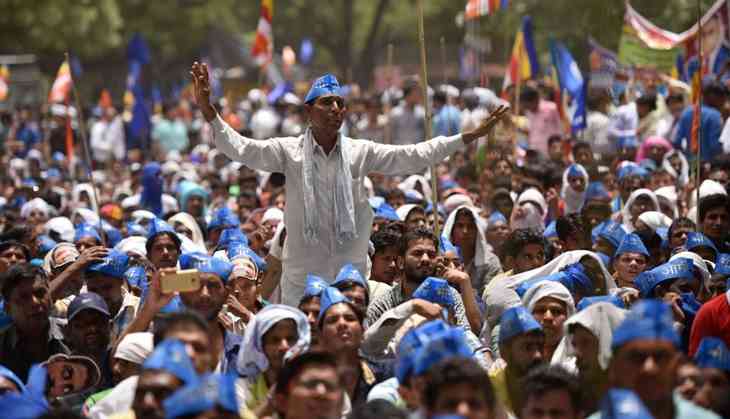Saharanpur's Bhim Army is no threat to Mayawati. It's helping rebuild BSP

Does the Bhim Army pose a threat to the Bahujan Samaj Party?
Locals in Saharanpur knew little of the outfit before the recent caste clashes.
“I have not heard of any Bhim Army,” Mohammad Hamza, who manages a school, told this reporter after the 9 May violence in many villages on the periphery of Saharanpur.
Local journalists, some of whom had their vehicles burnt in the incident, did not have much information to share about the organisation or its background. It was one of the many largely unknown outfits active in the large district.
How Bhim Army shot to infamy
Everything changed after the 9 May incident, when a group of Dalits attacked the local administration, leading to injuries to a senior police officers, journalists and others. This propelled the Bhim Army to the front pages.
The intensity of the 9 May violence had taken the police by surprise. Rumour has it that some of the officials had to resort to saying 'Jai Bhim' to escape the wrath of the mob.
Subhash Chandra Dubey, the then-Senior Superintendent of Police, who was later suspended for his mishandling of the situation, had told Catch about 24 cases of violence related to 9 May that the police had registered against the mob, including members of the Bhim Army and its chief, who goes by the moniker of Chandrashekhar Azad 'Ravan'.
Aiding the BSP
The 21 May protest at Jantar Mantar in New Delhi, called by 'Ravan' against what he called the 'biased' police and district administration, saw a sea of blue in the capital, with an attendance estimated to be over 10,000.
The protest led to speculation if an outfit like the Bhim Army could fill in for the BSP, which had recently been trounced in the Assembly elections.
BSP supremo Mayawati stated after another round of violence on 23 May that the BJP was supporting the Bhim Army. This lent credence to assertions that the outfit was anti-BSP.
The sense on the ground, however, is totally different. The administration, politicians and locals say the outfit is helping the BSP get back on its feet.
“All through the day, I kept receiving messages from the members of the BSP about the protest,” a Rashtriya Lok Dal leader told this reporter about the 21 May protest. “The mobilisation could not have been possible without the BSP,” the politician said, suggesting how BSP was helping the outfit.
Locals like Khazan Singh, a Dalit from Ramnagar village, the site of violence on 9 May, also recalls that the Bhim Army supported the BSP in the 2017 Assembly polls. “They were campaigning in favour of the BSP,” Singh recalled.
Why there's space for Bhim Army
A local Dalit lawyer in Saharanpur explained that the core of the Bhim Army consists of Jatavs, and that non-Jatav Dalits are few and far between, even though it talks of Dalit unity. “This has been a problem with all the Dalit formations, that they have not been able to unite the many communities,” the lawyer had conceded.
Jatavs form an overwhelming majority of the Dalit population in western UP, and are better off than other communities. They also form the core of Mayawati's votebank, leaving other communities like the Valmikis to gravitate to the BJP.
In the last two elections, there were reports of even some Jatav voters choosing the BJP over the BSP.
Saharanpur, with its sizeable Dalit population, was once Mayawati's karmabhoomi, the centre of the BSP's politics.
With a BJP government in power and reassertion by the upper castes like the Thakurs, the Bhim Army has enough space to keep the pot simmering, and keep the Dalits, at least the Jatavs, away from the BJP.
“Among the more than 60 caste groups, we are the only ones who realise the worth of our Dalit identity. The rest of the communities are caught in the Brahmanical trap,” Yogesh Kumar, a Dalit student, who had come from Ghaziabad for the 21 May protest, had told this reporter. He wore a cap, which read, 'The Great Chamar', also the tagline of the Bhim Army, which is reminiscent of Mayawati's 'Chamari hoon par tumhari hoon' slogan, used aggressively as she rose to prominence in UP politics.
Local Dalits, meanwhile, have an interesting take on the Bhim Army. Some, like Praveen Kumar from Badgaon village, are upset with the present lot of BSP leaders. “Nobody listened to Mayawati, and that is why they are behind Chandrashekhar Azad,” he said.
Others, though, seem to have a more nuanced view.
“Dalit politicians were not doing enough,” Monu Kumar, a Dalit student at the Ravidas Hostel in Saharanpur, said. “Political leaders like Mayawati have their limitations. They could not hit the streets to take up our issues.” This, he said, created space for the Bhim Army.
Can Bhim Army replace BSP?
Even the state police officials who are investigating the violent incidents in Saharanpur say that the “Bhim Army is a disruptor” and suits BSP the most – although even parties like the Congress have come out in support of the outfit. They claim that the group could have about 50 members who form the core, and several thousand others enrolled as members.
Can an outfit like this replace the BSP in the longer run? “BSP is in our blood. Bhim Army is just a social outfit,” Monu Kumar said.
Mayawati's opposition and distancing from the outfit may just be the politically correct thing to do, to not just maintain her larger-than-life image among the Dalit voters, but to also put the ball back in the court of the BJP, which has been accusing the BSP of supporting the Bhim Army and fomenting trouble in Saharanpur.
It is unlikely that the multiple-time Chief Minister of UP would feel threatened by an outfit which shot to fame a little less than a month ago.
First published: 30 May 2017, 22:57 IST
